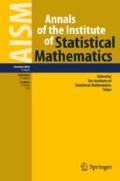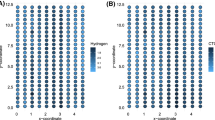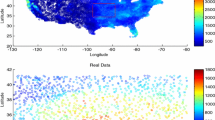Abstract
The best linear unbiased predictor (BLUP) is called a kriging predictor and has been widely used to interpolate a spatially correlated random process in scientific areas such as geostatistics. However, if an underlying random field is not Gaussian, the optimality of the BLUP in the mean squared error (MSE) sense is unclear because it is not always identical with the conditional expectation. Moreover, in many cases, data sets in spatial problems are often so large that a kriging predictor is impractically time-consuming. To reduce the computational complexity, covariance tapering has been developed for large spatial data sets. In this paper, we consider covariance tapering in a class of transformed Gaussian models for random fields and show that the BLUP using covariance tapering, the BLUP and the optimal predictor are asymptotically equivalent in the MSE sense if the underlying Gaussian random field has the Matérn covariance function.

Similar content being viewed by others
References
Bickel, P.J., Doksum, K.A. (1981). An analysis of transformations revisited. Journal of the American Statistical Association, 76, 296–311.
Box, G.E.P., Cox, D.R. (1964). An analysis of transformations. Journal of the Royal Statistical Society Series B, 26, 211–252.
Brockwell, P.J., Davis, R.A. (1991). Time series: theory and methods (2nd ed.). New York: Springer.
Cressie, N. (1993). Statistics for spatial data, revised edition. New York: Wiley.
De Oliveira, V. (2006). On optimal point and block prediction in log-Gaussian random fields. Scandinavian Journal of Statistics, 33, 523–540.
Du, J., Zhang, H., Mandrekar, V.S. (2009). Fixed-domain asymptotic properties of tapered maximum likelihood estimators. Annals of Statistics, 37, 3330–3361.
Fuentes, M., Reich, B. (2010). Spectral domain. In A. E. Gelfand, P. J. Diggle, M. Fuentes, & P. Guttorp (Eds.), Handbook of spatial statistics. Boca Raton: Chapman and Hall/CRC.
Furrer, R., Genton, M.G., Nychka, D. (2006). Covariance tapering for interpolation of large spatial datasets. Journal of Computational and Graphical Statistics, 15, 502–523. (Erratum and Addendum: Journal of Computational and Graphical Statistics, 21, 823–824).
Furrer, R., Sain, S.R. (2010). spam: a sparse matrix R package with emphasis on MCMC methods for Gaussian markov random fields. Journal of Statistical Software, 36(10), 1–25.
Golub, G.H., Van Loan, C.F. (1996). Matrix computations. Baltimore: Johns Hopkins University Press.
Gradshteyn, I.S., Ryzhik, I.M. (2007). Table of integrals, series, and products (7th ed.). Amsterdam: Academic Press.
Granger, C.W. J., Newbold, P. (1976). Forecasting transformed series. Journal of the Royal Statistical Society: Series B, 38, 189–203.
Hirano, T., Yajima, Y. (2012). Covariance tapering for prediction of large spatial data sets in transformed random fields. Discussion paper CIRJE-F-823, Graduate School of Economics, University of Tokyo, Tokyo (http://www.cirje.e.u-tokyo.ac.jp/research/dp/2011/list2011.html).
Johns, C., Nychka, D., Kittel, T., Daly, C. (2003). Infilling sparse records of spatial fields. Journal of the American Statistical Association, 98, 796–806.
Kaufman, C., Schervish, M., Nychka, D. (2008). Covariance tapering for likelihood- based estimation in large spatial data sets. Journal of the American Statistical Association, 103, 1545–1555.
Moyeed, R.A., Papritz, A. (2002). An empirical comparison of kriging methods for nonlinear spatial point prediction. Mathematical Geology, 34, 365–386.
Olver, F.W., Daniel, W.L., Boisvert, R.F., Clark, C.W. (2010). NIST handbook of mathematical functions. New York: Cambridge University Press.
Putter, H., Young, G.A. (2001). On the effect of covariance function estimation on the accuracy of kriging predictors. Bernoulli, 7, 421–438.
Stein, M.L. (1993). A simple condition for asymptotic optimality of linear predictions of random fields. Statistics and Probability Letters, 17, 399–404.
Stein, M.L. (1999). Interpolation of spatial data. New York: Springer.
Stein, M. L. (2010). Asymptotics for spatial processes. In A. E. Gelfand, P.J. Diggle, M. Fuentes, P. Guttorp (Eds.), Handbook of spatial statistics. Boca Raton: Chapman and Hall/CRC.
Wackernagel, H. (2003). Multivariate geostatistics: an introduction with applications. Berlin: Springer.
Wang, D., Loh, W.-L. (2011). On fixed-domain asymptotics and covariance tapering in Gaussian random field models. Electronic Journal of Statistics, 5, 238–269.
Wendland, H. (1995). Piecewise polynomial, positive definite and compactly supported radial functions of minimal degree. Advances in Computational Mathematics, 4, 389–396.
Yakowitz, S.J., Szidarovszky, F. (1985). A comparison of kriging with nonparametric regression methods. Journal of Multivariate Analysis, 16, 21–53.
Zhu, Z., Wu, Y. (2010). Estimation and prediction of a class of convolution-based spatial nonstationary models for large spatial data. Journal of Computational and Graphical Statistics, 19, 74–95.
Acknowledgments
The authors are grateful to Professor Akimichi Takemura and Professor Mark G. Genton for helpful comments and discussions. We also acknowledge the suggestions from the associate editor and three anonymous referees that refined and improved the manuscript. This work is supported by the Research Fellowship (DC1) from the Japan Society for the Promotion of Science and by the Grants-in-Aid for Scientific Research (A) 23243039 from the Japanese Ministry of Education, Science, Sports, Culture and Technology.
Author information
Authors and Affiliations
Corresponding author
About this article
Cite this article
Hirano, T., Yajima, Y. Covariance tapering for prediction of large spatial data sets in transformed random fields. Ann Inst Stat Math 65, 913–939 (2013). https://doi.org/10.1007/s10463-013-0399-8
Received:
Revised:
Published:
Issue Date:
DOI: https://doi.org/10.1007/s10463-013-0399-8




